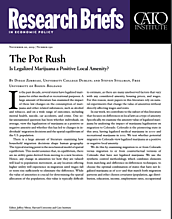In the past decade, several states have legalized marijuana for either medical or recreational purposes. A large amount of literature has examined the impact of these law changes on the consumption of marijuana and other related substances, such as alcohol and tobacco, and on a wide range of outcomes, including mental health, suicide, car accidents, and crime. One so-far-unexamined question has been whether individuals, on average, view the legalization of marijuana as a positive or negative amenity and whether this has led to changes in individuals’ migration decisions and the spatial equilibrium of the U.S. population.
There is a large amount of literature examining how household migration decisions shape human geography. The typical starting point is the neoclassical model of spatial equilibrium. This model assumes that, in equilibrium, there are no utility gains derived from moving to a new location. Hence, any change in amenities (or how they are valued) will lead to population movement, as any location offering higher utility will experience in-migration until wages fall or rents rise sufficiently to eliminate the difference. While the value of amenities is crucial for determining the spatial allocation of the population, this value is typically difficult to estimate, as there are many unobserved factors that vary with any considered amenity, housing prices, and wages. For this reason, most papers in this literature rely on natural experiments that change the value of amenities without directly affecting wages and rents.
In our work, we contribute to the subset of this literature that focuses on differences in local laws as a type of amenity. Specifically, we examine the amenity value of legalized marijuana by analyzing the impact of marijuana legalization on migration to Colorado. Colorado is the pioneering state in this area, having legalized medical marijuana in 2000 and recreational marijuana in 2012. We test whether potential migrants to Colorado view legalized marijuana as a positive or negative local amenity.
We do this by examining migration to or from Colorado versus migration to or from counterfactual versions of Colorado that have not legalized marijuana. We use the synthetic control methodology, which combines elements from matching and difference-in-differences techniques, to choose the optimal combination of states that have not legalized marijuana as of 2017 and that match both migration patterns and other chosen covariates (population, age distribution, education, income, employment rates, occupational composition, per capita tax revenues, monthly housing costs, average temperature, and voting behaviors) in Colorado prior to marijuana legalization. We can then directly compare outcomes in Colorado after marijuana legalization with those in the optimal counterfactual version of Colorado.
We find strong evidence that potential migrants view legalized marijuana as a positive amenity, with in-migration significantly higher in Colorado compared with the counterfactual Colorado after the writing of the Ogden memo in October 2009, which effectively allowed for state laws already in place to be activated and for recreational use of marijuana after it was legalized in 2013. From 2005 to 2009, on average, 187,600 people migrated to Colorado in each year. Between 2010 and 2013, in-migration increased by 21,372 people per year (a 11.4 percent increase) in Colorado compared with the counterfactual state. After full legalization in 2013, in-migration further increased by 14,087 people per year (an additional 7.5 percent increase).
We find no evidence for significant changes in outmigration from Colorado relative to the counterfactual, suggesting that marijuana legalization did not change the equilibrium for individuals already living in the state. In total, 156,406 more people moved to Colorado than predicted based on migration into the counterfactual after the signing of the Ogden memo. Given that we find no impact on out-migration, this implies that marijuana legalization increased Colorado’s population by 3.2 percent as of 2015.
Our findings are consistent with evidence that around 60 percent of Americans support marijuana legalization and anecdotal evidence of states that have legalized marijuana attracting migrants. They are also consistent with most previous research that has, in general, found positive effects of legalization, such as reductions in youth suicide, traffic accidents, and crime. Furthermore, as legal marijuana is taxed and raises significant revenue for states, our findings are also consistent with individuals being attracted to states with increasing revenues.
Given that Colorado was an early adopter of marijuana legalization, it is unclear whether later states will attract population flows to the same extent. Overall, our findings suggest that the widespread movement to legalize marijuana in the United States has affected the distribution of the U.S. population. Depending on the nature of individuals attracted to states that are early legalizers of marijuana, there could also be consequences for marijuana consumption, direct and indirect tax collection, and the social welfare system. In addition, there might also be either a decline in wages or an increase in housing costs in Colorado as a result of the increased in-migration caused by marijuana legalization.
NOTE:
This research brief is based on Diego Zambiasi and Steven Stillman, “The Pot Rush: Is Legalized Marijuana a Positive Local Amenity?,” forthcoming, Economic Inquiry, https://onlinelibrary.wiley.com/doi/10.1111/ecin.12832.
About the Authors

This work is licensed under a Creative Commons Attribution-NonCommercial-ShareAlike 4.0 International License.
